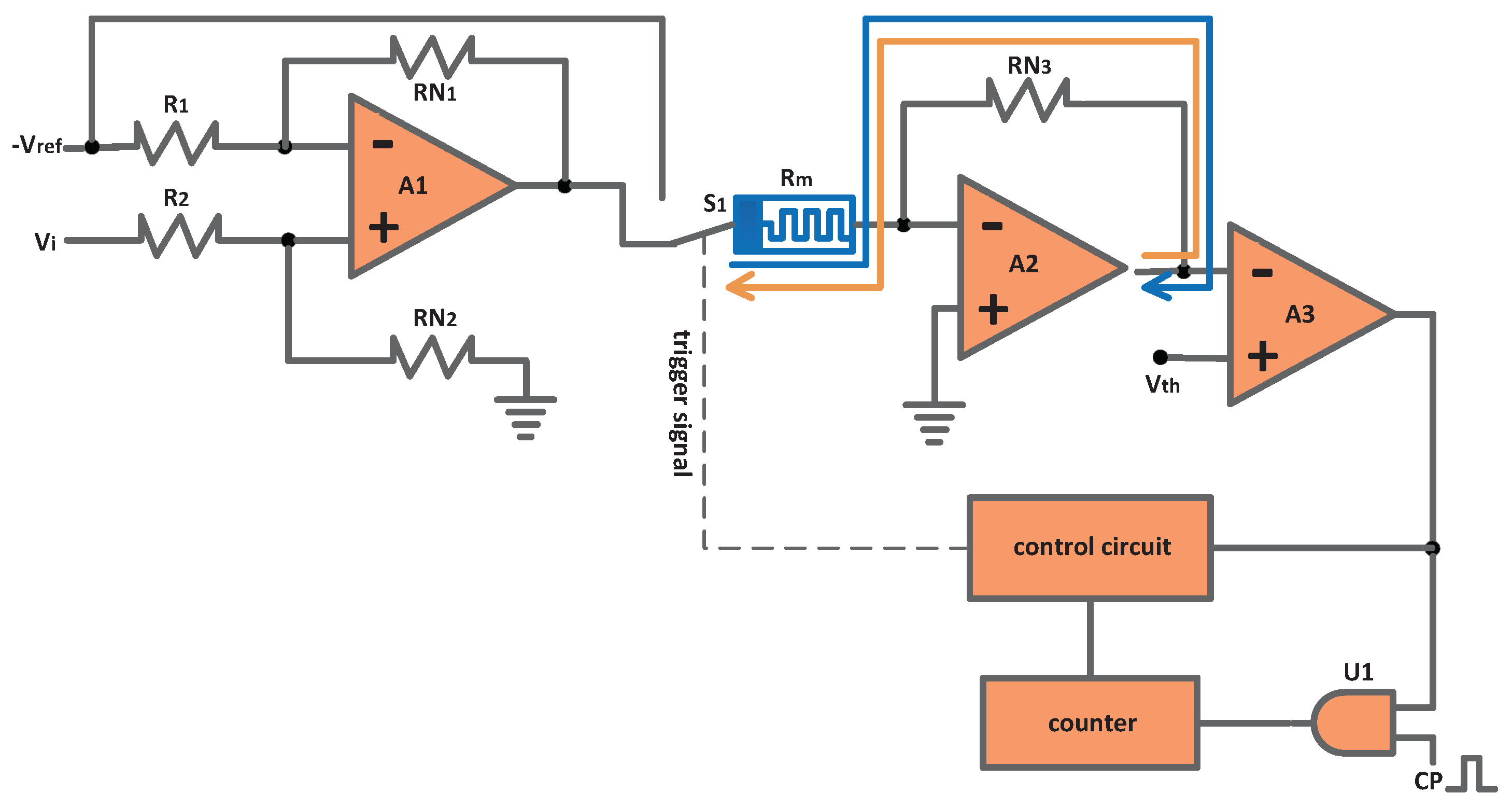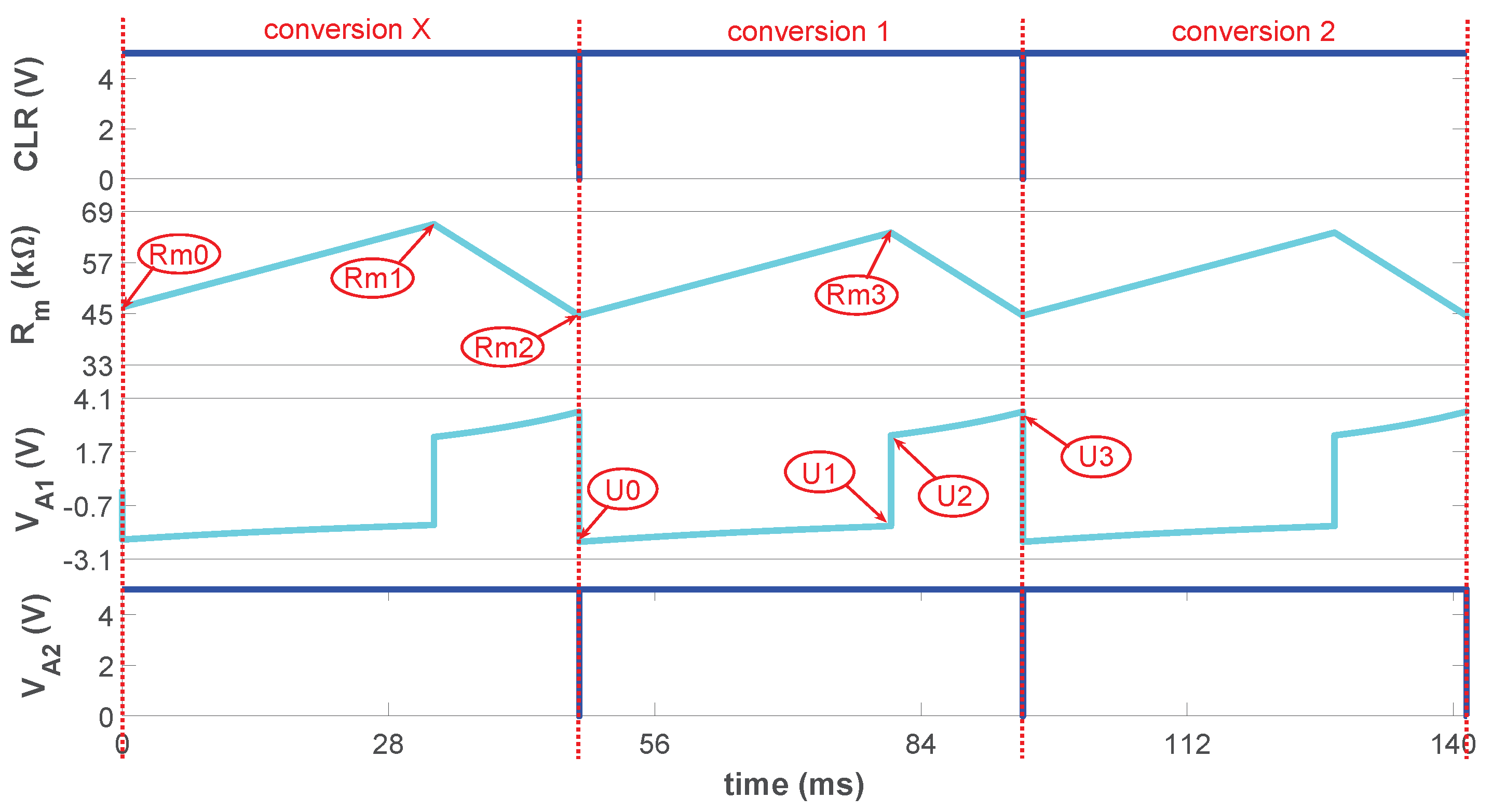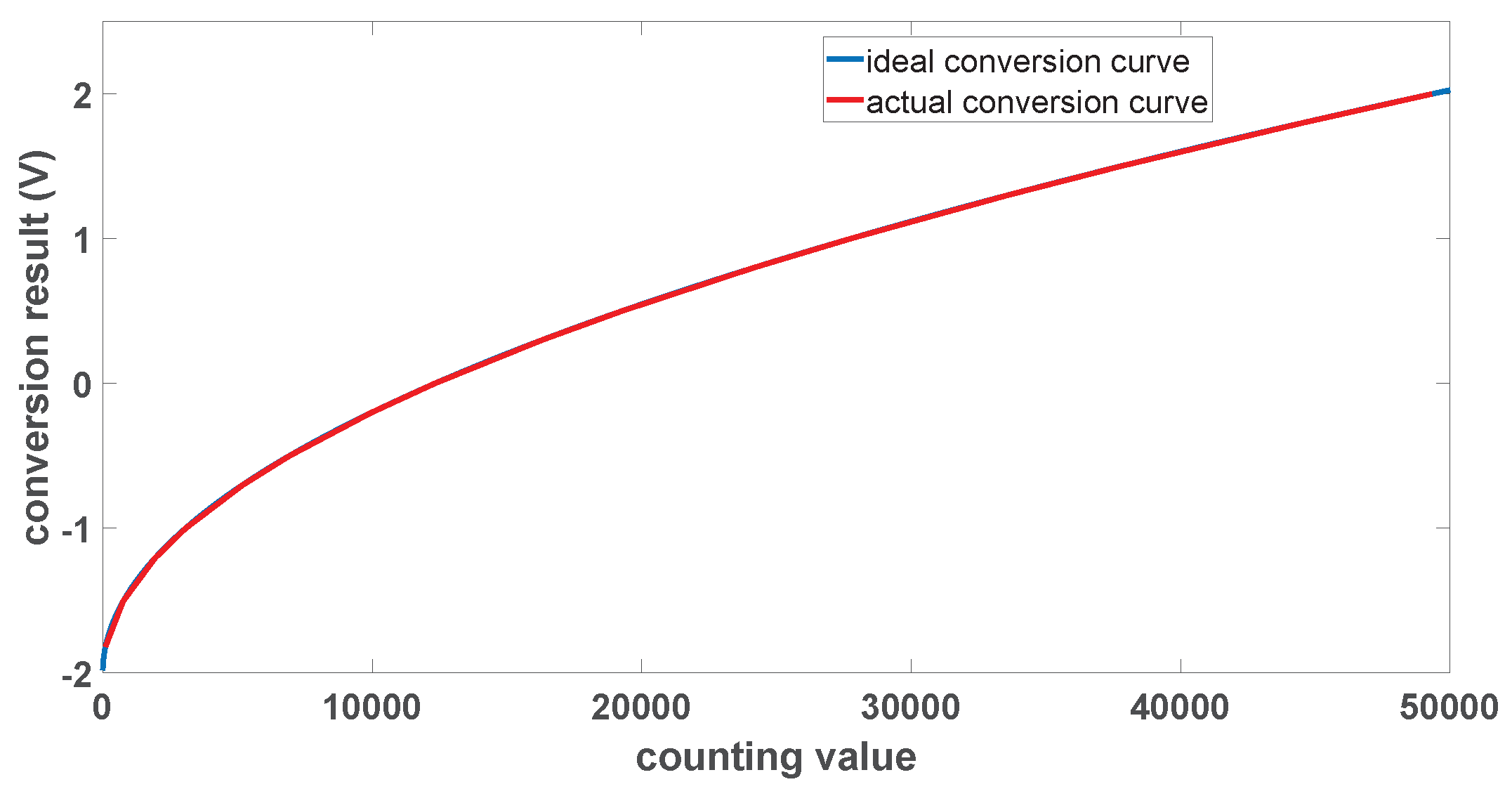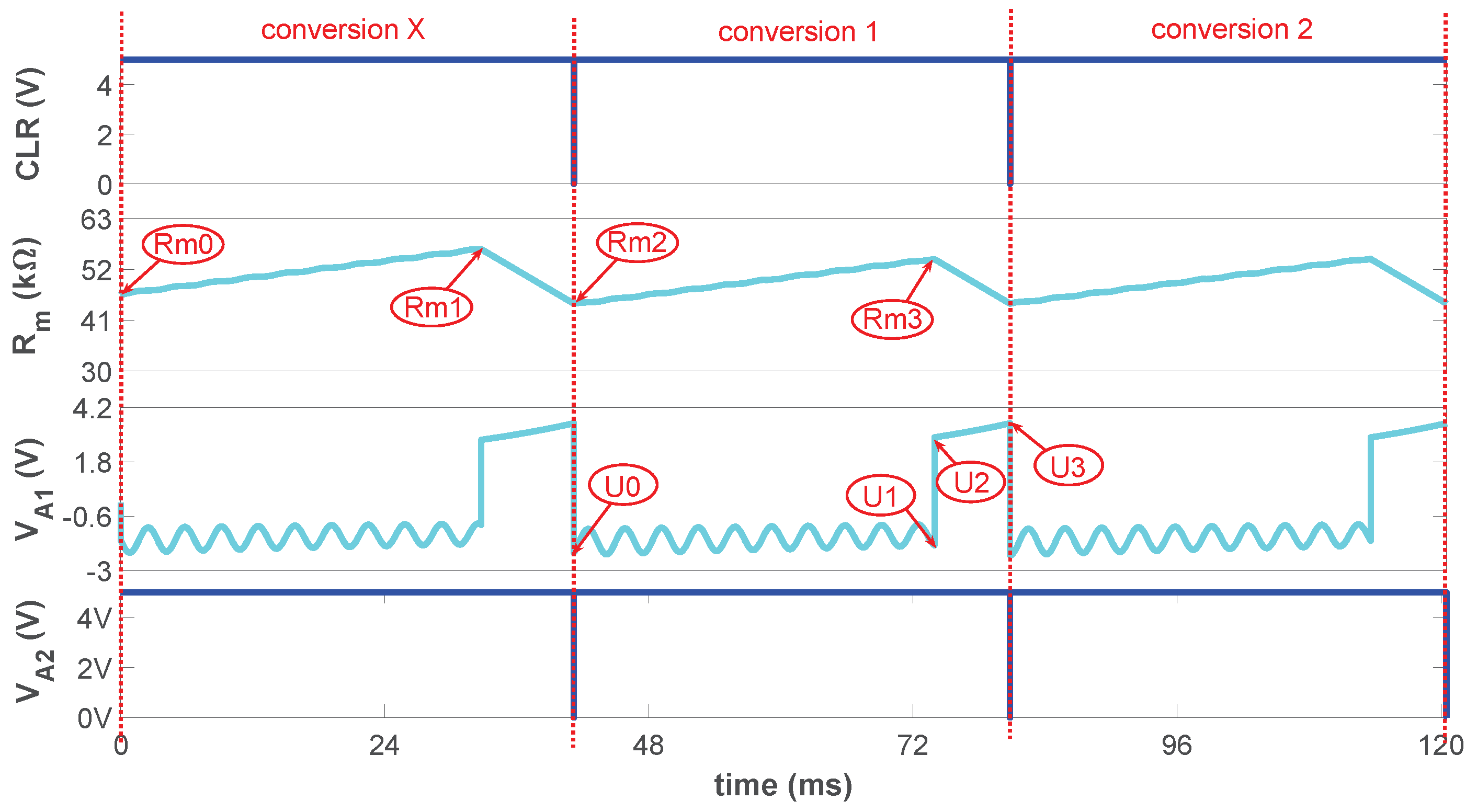A Memristor-Based High-Resolution A/D Converter
Abstract
1. Introduction
2. The Memristor-Based A/D Converter
2.1. Circuit Implementation of the Memristor-Based A/D Converter
2.2. Inference of Conversion Result
3. Simulations of the Memristor-Based A/D Converter
4. Anti-Interference Performance of the Memristor-Based A/D Converter
5. Discussion
6. Conclusions
Author Contributions
Funding
Institutional Review Board Statement
Informed Consent Statement
Data Availability Statement
Conflicts of Interest
References
- Rombouts, P.; De, W.W.; Weyten, L. A 13.5-b 1.2-V micropower extended counting A/D converter. IEEE J. Solid-State Circuits 2001, 36, 176–183. [Google Scholar] [CrossRef]
- Fahmy, G.A.; Pokharel, R.K.; Kanaya, H.; Yoshida, K. Indirect compensation technique based two-stage recycling folded cascode amplifier for reconfigurable multi-mode sigma-delta ADC. In Proceedings of the 2010 IEEE International Conference of Electron Devices and Solid-State Circuits (EDSSC), Hong Kong, China, 15–17 December 2010. [Google Scholar]
- Chua, L.O. Memristor-the missing circuit element. IEEE Trans. Circuit Theory 1971, 18, 507–519. [Google Scholar] [CrossRef]
- Strukov, D.B.; Snider, G.S.; Stewart, D.R.; Williams, R.S. The missing memristor found. Nature 2008, 453, 80–83. [Google Scholar] [CrossRef]
- Xia, Q.; Yang, J. Memristive crossbar arrays for brain-inspired computing. Nat. Mater. 2019, 18, 309–323. [Google Scholar] [CrossRef]
- Wang, K.; Hu, Q.; Gao, B.; Lin, Q.; Zhuge, F.W.; Zhang, D.Y.; Wang, L.; He, Y.H.; Scheicher, R.H.; Tong, H.; et al. Threshold switching memristor-based stochastic neurons for probabilistic computing. Mater. Horiz. 2021, 8, 619–629. [Google Scholar] [CrossRef]
- Yang, L.; Zeng, Z.; Huang, Y. An associative-memory-based reconfigurable memristive neuromorphic system with synchronous weight training. IEEE Trans. Cogn. Dev. Syst. 2020, 12, 529–540. [Google Scholar] [CrossRef]
- Hu, M.; Graves, C.E.; Li, C. Memristor-based analog computation and neural network classification with a dot product engine. Adv. Mater. 2018, 30, 1705914. [Google Scholar] [CrossRef]
- Sun, J.; Han, G.; Zeng, Z.; Wang, Y. Memristor-based neural network circuit of full-function pavlov associative memory with time delay and variable learning rate. IEEE Trans. Cybern. 2020, 50, 2935–2945. [Google Scholar] [CrossRef]
- Zhang, Y.; Wang, X.; Li, Y.; Friedman, E.G. Memristive model for synaptic circuits. IEEE Trans. Circuits Syst. II Exp. Briefs 2017, 64, 767–771. [Google Scholar] [CrossRef]
- Chen, L.; Li, C.; Chen, Y. A forgetting memristive spiking neural network for pavlov experiment. Int. J. Bifurc. Chaos 2018, 28, 1850080. [Google Scholar] [CrossRef]
- Shang, L.; Duan, S.; Wang, L.; Huang, T. SRMC: A multibit memristor crossbar for self-renewing image mask. IEEE Trans. Very Large Scale Integ. (VLSI) Syst. 2018, 26, 2830–2841. [Google Scholar] [CrossRef]
- Karimi, A.; Rezai, A. High-performance digital logic implementation approach using novel Memristor-based multiplexer. Int. J. Circ. Theor. Appl. 2019, 47, 1933–1947. [Google Scholar] [CrossRef]
- Karimi, A.; Rezai, A. Novel design for a memristor-based full adder using a new IMPLY logic approach. J. Comput. Eletron. 2018, 17, 1303–1314. [Google Scholar] [CrossRef]
- Karimi, A.; Rezai, A. Novel design for Memristor-based n to 1 multiplexer using new IMPLY logic approach. IET Circuits Devices Syst. 2019, 13, 647–655. [Google Scholar] [CrossRef]
- Fahmy, G.A.; Zorkany, M. Design of a memristor-based digital to analog converter (DAC). Electronics 2021, 10, 622. [Google Scholar] [CrossRef]
- Yang, L.; Zeng, Z.; Ma, Z.; Shan, W. A memristive dual-slope A/D converter. Int. J. Circuit Theory Appl. 2020, 48, 42–55. [Google Scholar] [CrossRef]
- Yang, Y.; Li, D.; Wang, D. Dynamic analysis of the switched-inductor buck-boost converter based on the memristor. Electronics 2021, 10, 452. [Google Scholar] [CrossRef]
- Wang, M.; Yan, Z.; Wang, T.; Cai, P.; Gao, S.; Zeng, Y.; Wan, C.; Wang, H.; Pan, L.; Yu, J.; et al. Gesture recognition using a bioinspired learning architecture that integrates visual data with somatosensory data from stretchable sensors. Nat. Electron. 2020, 3, 563. [Google Scholar] [CrossRef]
- Ostrovskii, V.; Fedoseev, P.; Bobrova, Y.; Cai, P.; Gao, S.; Zeng, Y.; Wan, C.; Wang, H.; Pan, L.; Yu, J.; et al. Structural and parametric identification of Knowm memristors. Nanomaterials 2021, 12, 63. [Google Scholar] [CrossRef]
- Aguirre, F.L.; Sune, J.; Miranda, E. SPICE implementation of the dynamic memdiode model for bipolar resistive switching devices. Micromachines 2022, 13, 330. [Google Scholar] [CrossRef]
- Kvatinsky, S.; Ramadan, M.; Friedman, E.G.; Kolodny, A. VTEAM: A general model for voltage-controlled memristors. IEEE Trans. Circuits Syst. II Exp. Brief 2015, 62, 786–790. [Google Scholar] [CrossRef]
- Yalon, E.; Gavrilov, A.; Cohen, S.; Mistele, D.; Meyler, B.; Salzman, J.; Ritter, D. Resistive Switching in HfO2 Probed by a Metal-Insulator-Semiconductor Bipolar Transistor. IEEE Electron. Device Lett. 2011, 33, 11–13. [Google Scholar] [CrossRef]
- Chanthbouala, A.; Garcia, V.; Cherifi, R.O.; Bouzehouane, K.; Fusil, S.; Moya, X.; Xavier, S.; Yamada, H.; Deranlot, C.; Mathur, N.D.; et al. A ferroelectric memristor. Nat. Mater. 2012, 11, 860–864. [Google Scholar] [CrossRef]
- Johnson, S.L.; Sundararajan, A.; Hunley, D.P.; Strachan, D.R. Memristive switching of single-component metallic nanowires. Nanotechnology 2010, 21, 125204. [Google Scholar] [CrossRef]
- Tank, D.; Hopfield, J. Simple neural optimization networks: An A/D converter, signal decision circuit, and a linear programming circuit. IEEE Trans. Circuits Syst. 1986, 33, 533–541. [Google Scholar] [CrossRef]
- Gao, L.; Merrikh, B.F.; Alibart, F.; Guo, X.; Hoskins, B.D.; Cheng, K.T.; Strukov, D.B. Digital-to-analog and analog-to-digit conversion with metal oxide memristors for ultra-low power computing. In Proceedings of the 2013 IEEE/ACM International Symposium on Nanoscale Architectures, Brooklyn, NY, USA, 15–17 July 2013; pp. 19–22. [Google Scholar]
- Guo, X.; Farnood, M.B.; Gao, L.; Hoskins, B.D.; Alibart, F.; Linares-Barranco, B.; Theogarajan, L.; Teuscher, C.; Strukov, D.B. Modeling and experimental demonstration of a hopfield network analog-to-digital converter with hybrid CMOS/memristor circuits. Front. Neurosci. 2015, 9, 488. [Google Scholar] [CrossRef]
- Wang, W.; You, Z.; Liu, P.; Kuang, J. An adaptive neural network A/D converter based on CMOS/memristor hybrid design. IEICE Electron. Expr. 2014, 11, 1–6. [Google Scholar] [CrossRef][Green Version]
- Pershin, Y.V.; Sazonov, E.M.; Di, V. Analogue-to-digital and digital-to-analogue conversion with memristive devices. Electron. Lett. 2012, 48, 73–74. [Google Scholar] [CrossRef]
- Kang, H. Fundamentals of Electronic Technology; Higher Educ Press: Beijing, China, 2006. [Google Scholar]
- Neamen, D.A. Microelectronics: Circuit Analysis and Design; McGraw-Hill: Boston, MA, USA, 2007. [Google Scholar]




| - | First Simulation | Second Simulation | Third Simulation | Fourth Simulation |
|---|---|---|---|---|
| () | 1000 | 1000 | 1000 | 1000 |
| () | 100,000 | 100,000 | 100,000 | 100,000 |
| (m) | 3 × 10 | 3 × 10 | 3 × 10 | 3 × 10 |
| (m) | 0 | 0 | 0 | 0 |
| (m/s) | 5 × 10 | 2 × 10 | 6 × 10 | 2 × 10 |
| (m/s) | −5 × 10 | −2 × 10 | −6 × 10 | −3.4 × 10 |
| (V) | 0.8 | 1 | 1 | 1 |
| (V) | −0.8 | −1 | −1 | −1 |
| 1 | 2 | 3 | 2 | |
| 1 | 2 | 3 | 3 | |
| (m) | 1.38 × 10 | 1.38 × 10 | 1.38 × 10 | 1.38 × 10 |
| conversion result (1 V) | 0.999 V | 0.999 V | 0.999 V | 0.999 V |
| the Amplitude and Frequency of Sine Noise | Actual Analog Voltage | the Amplitude of Input Voltage | Conversion Result |
|---|---|---|---|
| 0.2 v (300 Hz) | 0 v | 0.2 v | 0.003 v |
| 0.4 v (300 Hz) | 0 v | 0.4 v | 0.018 v |
| 0.6 v (300 Hz) | 0 v | 0.6 v | 0.039 v |
| 0.8 v (300 Hz) | 0 v | 0.8 v | 0.067 v |
| 1.0 v (300 Hz) | 0 v | 1 v | 0.109 v |
| 1.2 v (300 Hz) | 0 v | 1.2 v | 0.165 v |
| the Amplitude and Frequency of Sine Noise | Actual Analog Voltage | the Amplitude of Input Voltage | Conversion Result |
|---|---|---|---|
| 0.2 v (3000 Hz) | 1 v | 1.2 v | 1.004 v |
| 0.4 v (3000 Hz) | 1 v | 1.4 v | 1.014 v |
| 0.6 v (3000 Hz) | 1 v | 1.6 v | 1.036 v |
| 0.8 v (3000 Hz) | 1 v | 1.8 v | 1.057 v |
| 1.0 v (3000 Hz) | 1 v | 2 v | 1.086 v |
| 1.2 v (3000 Hz) | 1 v | 2.2 v | 1.123 v |
| - | Circuit Structure | Timing | High Resolution | Memristor Manufacture | Anti-Interference Ability | Voltage-Controlled Memristor |
|---|---|---|---|---|---|---|
| [27,28] | - | - | no | complex | no | yes |
| [29] | - | - | no | simple | no | yes |
| [30] | - | - | no | complex | no | yes |
| [31,32] | complex | complex | yes | - | yes | - |
| [16] | - | - | yes | simple | no | yes |
| [17] | simple | simple | yes | simple | yes | no |
| this paper | simple | simple | yes | simple | yes | yes |
Publisher’s Note: MDPI stays neutral with regard to jurisdictional claims in published maps and institutional affiliations. |
© 2022 by the authors. Licensee MDPI, Basel, Switzerland. This article is an open access article distributed under the terms and conditions of the Creative Commons Attribution (CC BY) license (https://creativecommons.org/licenses/by/4.0/).
Share and Cite
Yang, L.; Ding, Z. A Memristor-Based High-Resolution A/D Converter. Electronics 2022, 11, 1470. https://doi.org/10.3390/electronics11091470
Yang L, Ding Z. A Memristor-Based High-Resolution A/D Converter. Electronics. 2022; 11(9):1470. https://doi.org/10.3390/electronics11091470
Chicago/Turabian StyleYang, Le, and Zhixia Ding. 2022. "A Memristor-Based High-Resolution A/D Converter" Electronics 11, no. 9: 1470. https://doi.org/10.3390/electronics11091470
APA StyleYang, L., & Ding, Z. (2022). A Memristor-Based High-Resolution A/D Converter. Electronics, 11(9), 1470. https://doi.org/10.3390/electronics11091470






